Genus
Andinoacara
Zuzana Musilova, Ingo Schindler
and Wolfgang Staeck 2009
©Text and photos by Alf Stalsberg,
unless otherwise indicated.
CLICK ON ANY IMAGE TO ENLARGE IT
Since we have got a new Genus for many of our earlier Aequidens I made a new page in English and Norwegian and I will transfer the fish to this page. There are several of these fishes that are not described, but I hope this will happen in the end. As I have said several times, we have not seen the end of new fishes.
Andinoacara blombergi (Günther, 1859)
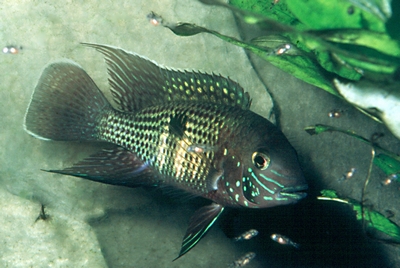 |
Andinoacara blombergi and fry. |
Andinoacara (Aequidens) blombergi was described by Günther in 1859 as Aequidens rivulatus, and as Andinoacara blombergi in 2012 by Dr Kullander. This fish comes from the western part of Ecuador, from Esmeralda and some t the north. I have collected the fish in tributaries to Rio Esmeraldas. I'm not certain how far north the fish can be found, maybe as far as Rio Cayapes or even in Rio Sapayo and in Rio Santiago. Material from these places might be marked as Andinoacara (Aequidens) sapayensis, and can be synonym for Andinoacara (Aequidens) blombergi . I think this needs further investigation to find out how far north Andinoacara (Aequidens) blombergi lives.
I collected the fish for the first time in 1987 in a small river 24 km west of the city Quininde (Rosa Zarate) in Ecuador. The material that was collected was sent to the National History Museum in Stockholm to Dr Kullander, who compared my material with Günther's material in London and said that the fishes I had collected near Quininde was the real Andinoacara (Aequidens) rivulatus (Günther 1859)
Andinoacara rivulatus (Goldsaum) (Gunther 1859)
BELOW: A young male Andinoacara rivulatus.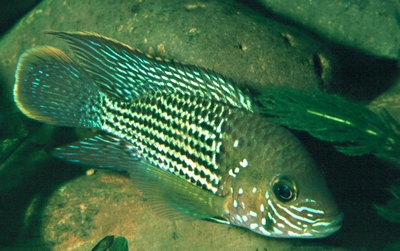
|
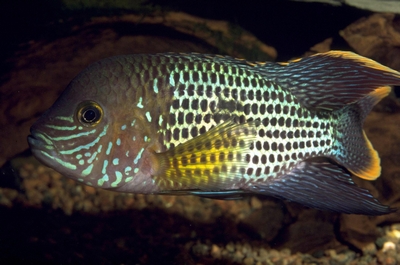 ABOVE: Andinoacara rivulatus.
ABOVE: Andinoacara rivulatus.
|
There is a ridge that goes from the Andes in the east and out to Esmeraldas in the west. On this ridge there is a town called Santo Domingo de Los Colorados. Rivers south of this city flow into the Rio Daule Daule which ends in the Bay of Guayaquil near the city of Guayaquil. The rivers out here are called the Guayas Riversystem and there are several rivers in this system. In these rivers we found the fish we call Goldsaum, or today, Andinoacara rivulatus. But this fish has also been called, Andinoacara aequinoctalis. This fish came on the market at the end of 1970, at least here in Scandinavia. Many say that this was the fish Gunther described in 1859 from Ecuador.
I did not agree with this and did more work with these fishes, and the more I learned about these fish I was certain that this fish we called "Aequidens" sp. Goldsaum was not Andinoacara (Aequidens) rivulatus. But I had to change my mind later.
So far, no one has done anything with this before 2008-09. It started with publishing a new Genus and that was Andinoacara. It is more than 20 years since the fish came on the market and now the fish will get a new Genus and a new name . There is still some confusion, but I think this soon will be cleared up.
Andinoacara stalsbergi (Silbersaum),
Zuzana Musilova, Ingo Schindler and Dr Wolfang Staeck, 2009
Andinoacara stalsbergi (Silbersaum)
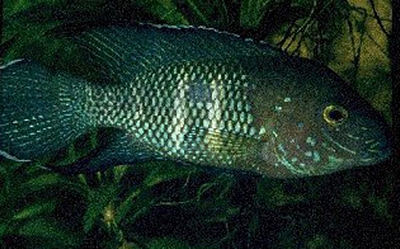 |
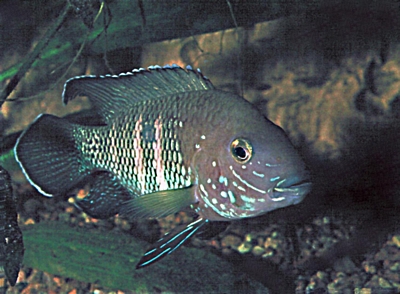
|
UNDER: Here we catch Andinoacara stalsbergi in a pond in the Rio Pisco in the dry season, we catch fish and have one in the bag. You see how great the fish are. We had some local kids as assistants.
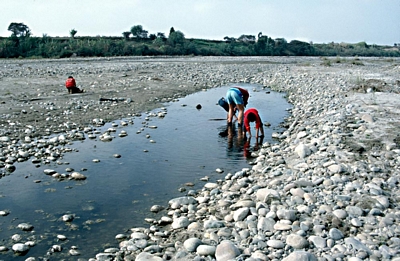 |
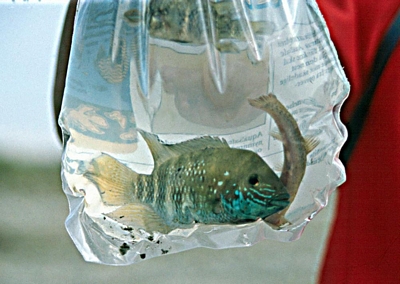
We would not be long in one place before we got spectators. |
RIGHT: Here we are in the lower reaches of the Rio Pisco. There is not much water in the river, but when we look at the tunnel entrances under the road we can see that the river, in the rainy season, has much more water.
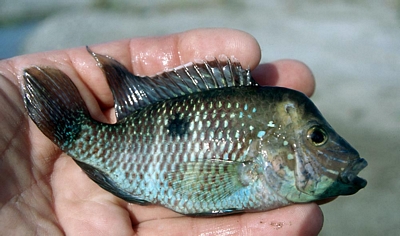 |
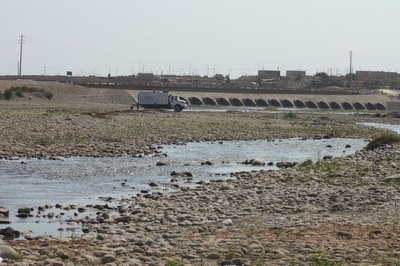
A very nice fish. |
We went higher up along Rio Pisco and came to a place called Puente Bernales, here there was more water and it was a nice biotope.
** This fish comes from Peru and in Europe we have called the fish Aequidens sp. Silbersaum (today Andinoacara) , or Silverseam. It was Dr Lüling who caught the fish in 1972 and sent 2000 fish to the USA. The fish came later to Europe and I got my first fish from a friend of mine in 1975 (Jan Carlen) from Haugesund. There it was sold as "Aequidens" rivulatus.
When Andinoacara (Aequidens sp. Goldsaum) came on the market at the end of the '70s, it looked like people had forgotten about the Silverseam (The Green Terror) from Peru and they called this new one from Ecuador "Aequidens" rivulatus. I did not agree about this since I still had Aequidens sp. Silverseam (Green Terror) from Peru. But of course I could not be certain that I was right.
I had been working hard with these fish since then, and as a result of this work, I went on my first trip to Ecuador in 1987. I collected a fish near Quininde (Rosa Zorate) as I mention earlier, but I did not know what I had collected. The conserved material was sent to Dr Sven O. Kullander. I did not know then that I had collected the real Andinoacara (Aequidens) rivulatus, partly because I did not manage to bring live fish home. Only conserved material was sent to Stockholm to Dr Sven O. Kullander.
I went back to Ecuador again in 1989 and I did collect in rivers south of Guyaquil and also south of Machala. The nearest town was La Avanzada and I followed the road to Balsa and passed the river Rio Arenillas. There I collected Andinoacara sp. Goldsaum (Aequidens sp. Goldsaum) and Cichlasoma festae. The last week I went up to the biotope 24 km west from the city Quininde, and succeded in collecting and bringing back home Andinoacara (Aequidens) rivulatus. But still I did not know that the fish I collected was the real Andinoacara (Aequidens) rivulatus.
The fishes grew up and became some really nice specimens, and I began to compare the fish with the other. I did bother Kullander every time I was talking to him, and asked him if he had compared my material from Ecuador with the other. It took some years, but in a combination trip to London, he took the time to check Günther's material. And then he said it was quite sure I had collected the real Andinoacara (Aequidens) rivulatus. I went to Ecuador again in 1991, 1993, 2003, 2008 and 2011.
So then it's the Andinoacara stalsbergi from Peru, what was the widespread/distribution of the fish? It was on the Pacific side and that restricted the distribution, even if it was north and south in Peru. Dr Patrick de Rham was with me and to make this short we found the distribution of the fish Andinoacara stalsbergi (Silverseam). We also find that the southern distribution was Rio Pisco. When we spoke to Professor Hernan Ortega Torres, the head of the National History Museum in Lima, he said that they had not found Andinoacara stalsbergi (Silverseam) further south.
Then we flew up to the northern part of Peru, to Tumbes, to see if we could find how far north we would find the fish. We started with Rio Tumbes where we only collect Andinoacara sp. Goldsaum, we did not collect any Andinoacara stalsbergi (Silverseam) there. Next river was Rio Zarumilla and we collected in several places, but still only Andinoacara rivulatus (Goldsaum), and even in some small tributaries of Rio Zarumilla and in a tributary that was called Rio Faical we also collected Andinoacara rivulatus (Goldsaum).
I wanted to check rivers south from Tumbes when we were driving south to see if we could find Andinoacara rivulatus (Goldsaum) together with Andinoacara stalsbergi in the same river. But all the rivers south of Tumbes were (in Spanish) "Muy seco" or completely dry. There was no sign of water, only dry waterbeds where we were passing. We did not find any rivers with water before we came to a small village with the name Pueblo Mallares and this was about one hour north of Piura. Most of the land from Tumbes and down to Pueblo Mallares was only desert, only oil pumps were working.
Andinoacara biseriatus (C. Tate Regan 1913)
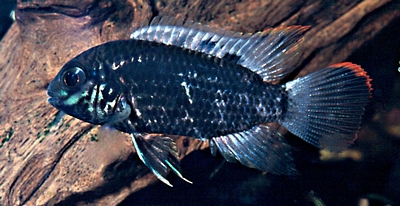 Andinoacara biseriatus female ready to spawn. Andinoacara biseriatus female ready to spawn. |
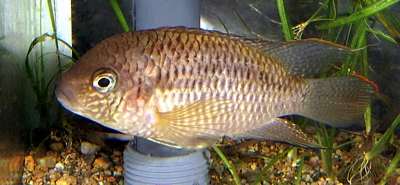 Andinoacara biseriatus male. Andinoacara biseriatus male.
|
When Regan described this fish in 1913 he did not call it "Aequidens" he called it Cichlosoma (sic) biseriatum. The fish was collected by Mr Spurell, and comes from Colombia in the Choco province. This province is in the western part Colombia and reaches up to the border of Panama. Type locality of the fish is Rio Condoto, a tributary of Rio San Juan.
My personal experience is that the fish is in several tributaries, not only tributaries of theRio San Juan, but also in tributaries to Rio Atrato. I collected the fish in a small river along the road out to Tado, but also around Istmina and along the The Pan American "Highway" from the village Panamericana (Las Animas), and in a small river called Rio Tirado, this river was a tributary to Rio Quito, which flows into Rio Atrato.
The fish grows to a size around 10-12 cm in total length. My biggest male was around 10 cm and the female was smaller. The colors are not so easy to describe, so I hope that the photos can give you an idea or impression of the fish. When they spawn, the female turns nearly black. But if you have seen adult Andinoacara biseriatus, you will easy recognise the fish from other Aequidens/Andinoacara.
In my aquarium they usually spawn on a flat rock, but I've also had fish that have spawned on broad leaves of a Swordplant. I have not tried to give them oakleaves, to see if they will spawn on these in the same way like the Bujurquina.
Andinoacara coeruleopunctatus (Kner & Steindachner 1863)
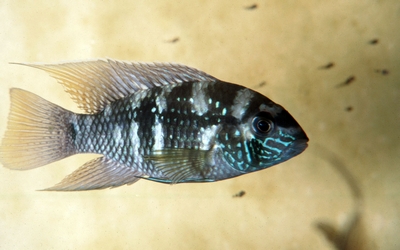
ABOVE: A male with fry.
RIGHT: Just-caught fish in everyday colors. |
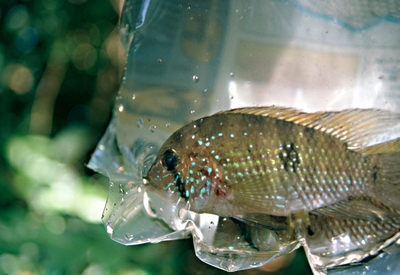 |
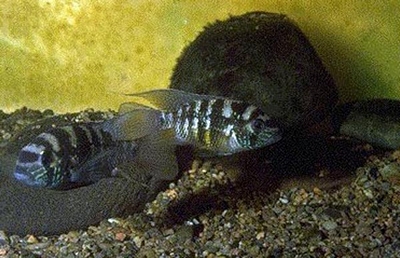 |
A pair of Andinoacara coeruleopunctatus in breeding colours.
|
This fish was first described by Kner & Steindachner as Acara coeruleopunctatus, and has later been described by several scientist like Pellegrin in 1904, Regan in 1905, Meek & Hildebrand in 1919 and again by Regan in 1913 as Cichlosoma (Æquidens) coeruleopunctatus and as Aequidens coeruleopunctatus, Eigenmann 1913.
This fish has been described under different names, so there is a lot of scientistic material about the fish. The type locality was Rio Chagre in the Canal Zone in Panama. But I'm not sure in which part of the Rio Chagre it was collected. Today the river is split in several parts, the upper part is from the beginning of the river to the Madden Dam, below the Madden Dam the river continues into the Lago Gatun which is the Panama Canal, before it comes to a new dam with a power station where the river flows out into the sea. But in which part of the river the fish was collected, I don't know, I'm not sure if the Madden Dam was there then. Rio Chagres starts up in the mountains and ends in Lago Alajuela. From there the the river flows into Lago Gatun near Gamboa. And as I said, on the other side of the lake the river ends close to the locks near Gatun, and they call it Rio Chagres.
But when I was in Panama last I did collect Andinoacara in many places. It was nearly all over, we collected it everywhere in the Canal Zone, but also in every river where we collected fish on our way down to Yaviza. All the rivers around Yaviza like Rio Chucunaque, Rio Tupisa and in a tributary to Rio Chucunaque, in Rio Chico and in small streams. We did find the fish in all rivers up to the border with Costa Rica.
But we did not find the fish on the Atlantic slope in Boca del Toro or in Rio Guarumo.
When I studied Andinoacara coeruleopunctatus in the water, I could not see any differences on the fish from Yaviza and around David. The only thing I noticed, was that the fish closer to the border to Costa Rica were more colorful. So I brought back new blood.
There is something else that puzzles me; a fish I kept for many years, that we now call Andinoacara (Aequidens) sapayensis. I got the fish from a friend of mine in Copenhagen, namely Ingemann Hansen, and he had got the fish from Germany. They call the fish Andinoacara (Aequidens) sapayensis, the name on the fish from Rio Sapayo in north-west Ecuador, and this is a tributary to Rio Cayapes.
So far I've not been in this river, but I'm quite sure I will. Andinoacara (Aequidens) coeruleopunctatus reminds me a lot of the fish we call Andinoacara (Aequidens) sapayensis. But since I've not collected the fish myself, I'm not sure where it comes from. The material I collected in Panama was sent to the National History Museum in Stockholm to Dr Kullander, so I just have to wait until he has time to check the material.
Andinoacara pulcher (Gill 1858)
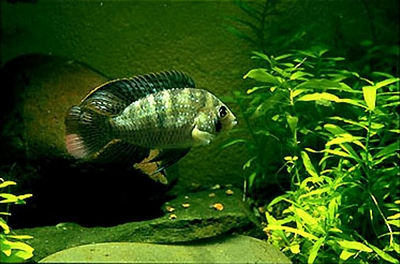 |
Aequidens pulcher of unknown origin. |
"Aequidens" pulcher (Gill 1858) is one of the oldest known Aequidens. This has been the first cichlid many aquarist have started with when they started with cichlids, and many still keep it. Or they maybe do as I do and get some of these fish again, because they are so nice.
The fish was described by Gill in 1858 and then not as Aequidens, but as Cychlasoma (sic) pulchrum from the western part of Trinidad. Later, many others have also described the fish until it ended up as "Aequidens" pulcher. It was placed in the "Aequidens" pulcher group, together with several others like "Aequidens" biseriatus (Regan 1913), "A." coeruleopunctatus (Kner & Steindachner), "A." rivulata Günther 1860 and "A." sapayensis (Regan 1903). Today these fish are moved to the new Genus Andinoacara.
It's obvious to many of us, that we are talking about more than species. But so far I don't know if there are any scientists looking at this. So we must keep these fishes apart from each other, so we don't get any mixing of the fish.
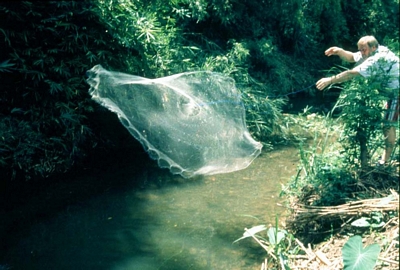
ABOVE: Just before I caught the Blue Cichlid.
RIGHT: Here I have the Blue Cichlid in a plastic bag. |
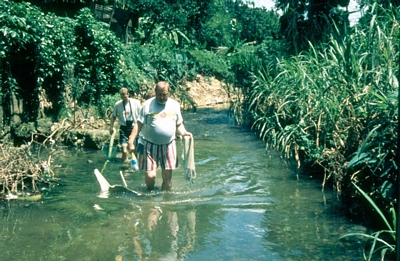
|
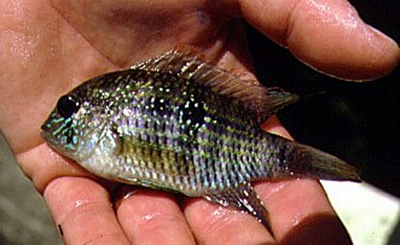 |
The true Blue Cichlid from Trinidad. |
Water samples from the biotope:
| 25°C |
31°C |
7.5 |
4 |
7 |
170 |
< 0.1 |
8°43´29"N x 79°53'06"W |
I went to Trinidad just to collect the Real Andinoacara (Aequidens) pulcher; we drove east on the Eastern Highway from Port of Spain and the first biotope was just before Aripa.
We collected Guppies, Andinoacara pulcher, Tetras, Brycon or was it Astyanax types, Ancistrus sp, Hypostomus sp, and Pimelodella/Rhamdia sp. Water samples were taken, see above.
This fish was sold as Blue Cichlid, but it's more brown than blue. I do not know the origin of these fish.
|
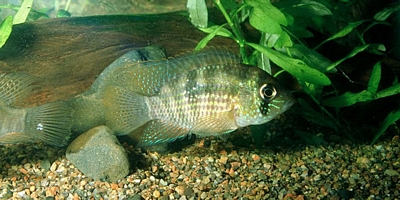 |
Andinoacara latifrons (Steindachner 1878)
This little river is a tributary of the Rio Cauca and its name is Aurra Quebrada. We passed it on the way to Choco. In this river we caught small fish that we believe were Aequidens latifrons.
|
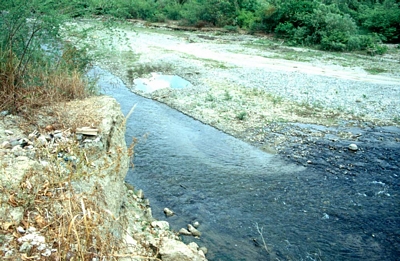
|
UNDER: We grabbed what we thought at first was Blue Cichlid. But as we came to it was Andinoacara (Aequidens) latifrons.
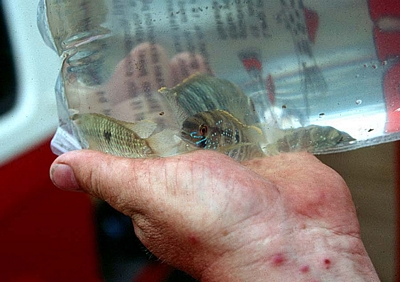
|
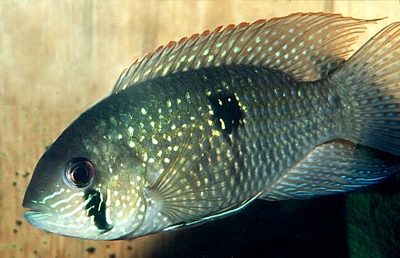
ABOVE: The fish we caught in the Rio Cauca, and we thought that this was Andinoacara (Aequidens) latifrons (?). |
UNDER: This fish comes from higher up in the Rio Cauca near Cali. Rainer Stawikowski also says that this is probably Andinoacara (Aequidens) latifrons.
Photo: Rainer Stawikowski.
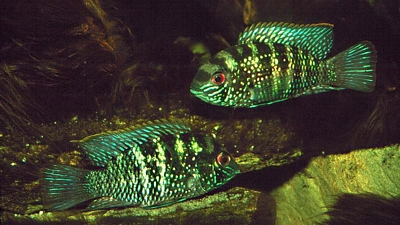
|
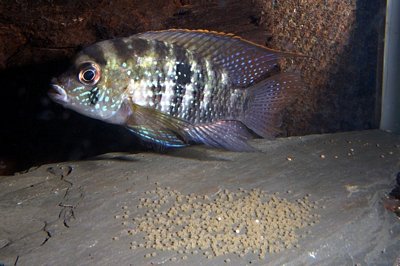
ABOVE: Where this fish, a female, was caught, I'm not sure. But it was in a shipment from Colombia. |
UNDER: My favorite position in a small river just before Tutunendo.
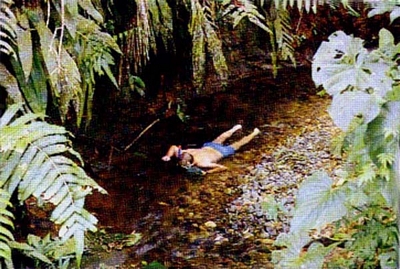
|
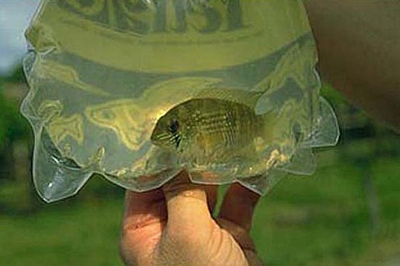
ABOVE: This is the fish I caught first in a small river before Tutunendo on our way to the Choco. We call it Aequidens sp. Choco. |
RIGHT: This is the female we caught out in the Choco, guarding eggs in the aquarium.
|
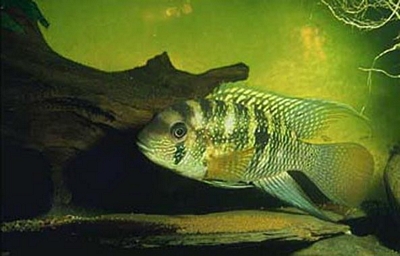 |
Andinoacara cf. pulcher "Venezuela"
This Aequidens cf. pulcher "Venezuela" was collected in north-eastern Venezuela on the Penisular Paria about 15 km south-east of the town of Carupano at the road between El Ricón and Los Arroyos. They are darker than Andinoacara pulcher from Trinidad, and they are also easy to keep and breed. The fish need more investigation to find out the relationship between the one from the island of Trinidad and this one on the mainland.
There are also other fish, that need to be studied more to find out if they are closely related.
Anyhow, it's a nice fish and not too big, you can keep it in an aquarium with plants and smaller fish that are not so small that they think it's food.
Here is a pair guarding eggs on a stone.
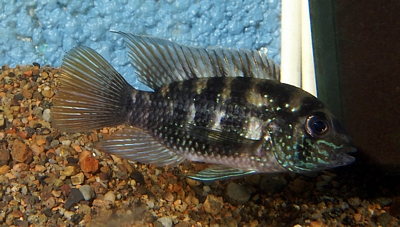 |
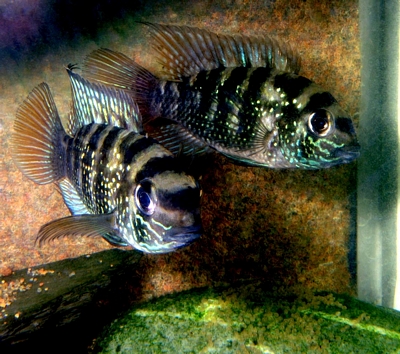 |
As you can see from the photos, the body color will change when they are breeding and guarding fry. Many Andinoacara and Aequidens do that.
Andinoacara "Aequidens" sapayensis (Regan, 1903)
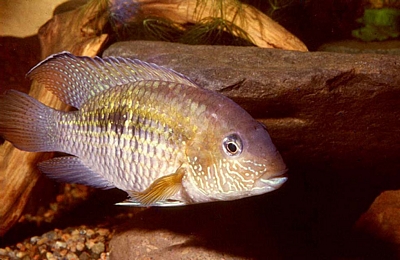 |
A large male of Andinoacara (Aequidens) sapayensis. |
I got Andinoacara (Aequidens) sapayensis from my good friend in Copenhagen, F. Ingemann Hansen, in the early '70s. He had got the fish from Germany.
The fish should have come from a tributary to Rio Sapayo called Rio Cayapas. I do not have a detailed map who can show me the river, but it should be near Rio Santiago on the west coast of Ecuador near San Lorenzo. I did not have time enough to check this out in 2003 and go to San Lorenzo, to find the Rio Sapayo, but I'm sure I'm going to Ecuador again, in combination with a visit to another country.
A female Andinoacara (Aequidens) sapayensis with eggs. |
|
This fish may also belong to the "Aequidens" pulcher group, and the fish may remind me about the "Aequidens sp." Choco or latifrons, but you can also compare it with Andinoacara (Aequidens) coeruleopunctatus.
The fish was easy to keep and was also willing to spawn, but I've not seen the fish since then. So you have to find the fish and find out if the name is correct or what. So I guess I must go back to Ecuador again.
The fish in the photo below here was also sold as Blue Acara, but you see that this fish is not very blue, but brown. No-one remembers where this fish came from. Now when the fish is about 10 cm and a couple have spawned, then you can really see the color on the fish. This fish reminds me of the fish we called Andinoacara (Aequidens) sapayensis in the seventies (see the photo above). So I guess I have to visit Ecuador again, to find the Rio Sapayo and to see if the fish is there.
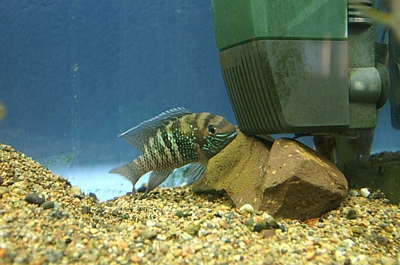 |
A female of what could be Andinoacara (Aequidens) sapayensis(?). |
Here is a photo of a female which I think could be the fish we called Andinoacara (Aequidens) sapayensis. Compare this photo with the second female on the right higher up on the page. I'm at least willing to believe that this fish could be the same. It's very frustrating to have a fish, and not knowing where it's from.
Aequidens sp. "Maracaibo"